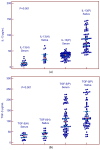Salivary Interleukin-13 and Transforming Growth Factor Beta as Potential Biomarkers of Cancer Cachexia
- PMID: 39272892
- PMCID: PMC11394294
- DOI: 10.3390/cancers16173035
Salivary Interleukin-13 and Transforming Growth Factor Beta as Potential Biomarkers of Cancer Cachexia
Abstract
Cancer cachexia is a syndrome characterized by weight and muscle loss and functional impairment, strongly influencing survival in cancer patients. In this study, we aimed to establish the role of saliva cytokine measurement in cancer cachexia investigation and define two potential independent salivary biomarkers of the condition.
Methods: serum and saliva specimens were obtained from 78 patients. Forty-six patients were non-cachectic, and 32 patients were cachectic (per SCRINIO group criteria), all with metastatic solid tumors. Commercial ELISA kits were used to determine the salivary and serum concentrations of interleukin 13 (IL-13) and transforming growth factor beta (TGF-β) in two patient groups and healthy controls. Laboratory values were obtained from the hospital information system, and weight and height were measured at the time of sampling.
Results: A statistically significant difference was observed between the groups in saliva IL-13 concentrations but no difference in serum concentrations. Statistically significant differences were also observed between the groups in saliva and serum concentrations of TGF-β. Logistic regression analysis has identified salivary IL-13 and TGF-β as independent factors for cancer cachexia.
Conclusions: We demonstrated saliva as a valuable specimen for cachexia investigation and established IL-13 and TGF-β as potential cancer cachexia biomarkers. Further research is needed to evaluate these findings.
Keywords: IL-13; TGF-ß; biomarker; cancer cachexia; cancer metabolism; cytokines; saliva.
Conflict of interest statement
The authors declare no conflicts of interest.
Figures








Similar articles
-
Tumour-derived transforming growth factor-β signalling contributes to fibrosis in patients with cancer cachexia.J Cachexia Sarcopenia Muscle. 2019 Oct;10(5):1045-1059. doi: 10.1002/jcsm.12441. Epub 2019 Jul 4. J Cachexia Sarcopenia Muscle. 2019. PMID: 31273954 Free PMC article.
-
Transforming Growth Factor-Beta Signaling in Cancer-Induced Cachexia: From Molecular Pathways to the Clinics.Cells. 2022 Aug 28;11(17):2671. doi: 10.3390/cells11172671. Cells. 2022. PMID: 36078078 Free PMC article. Review.
-
Cancer cachexia induces morphological and inflammatory changes in the intestinal mucosa.J Cachexia Sarcopenia Muscle. 2019 Oct;10(5):1116-1127. doi: 10.1002/jcsm.12449. Epub 2019 Jul 15. J Cachexia Sarcopenia Muscle. 2019. PMID: 31307125 Free PMC article.
-
Molecular therapeutic strategies targeting pancreatic cancer induced cachexia.World J Gastrointest Surg. 2018 Dec 27;10(9):95-106. doi: 10.4240/wjgs.v10.i9.95. World J Gastrointest Surg. 2018. PMID: 30622678 Free PMC article. Review.
-
Analysis of transforming growth factor beta and other cytokines in autoimmune exocrinopathy (Sjögren's syndrome).J Interferon Cytokine Res. 1995 Sep;15(9):759-67. doi: 10.1089/jir.1995.15.759. J Interferon Cytokine Res. 1995. PMID: 8536103
Cited by
-
Natural and induced immune responses in oral cavity and saliva.BMC Immunol. 2025 Apr 18;26(1):34. doi: 10.1186/s12865-025-00713-8. BMC Immunol. 2025. PMID: 40251519 Free PMC article. Review.
-
Leveraging Saliva for Insights into Head and Neck Cancer.Int J Mol Sci. 2024 Dec 17;25(24):13514. doi: 10.3390/ijms252413514. Int J Mol Sci. 2024. PMID: 39769275 Free PMC article. Review.
References
-
- Meza-Valderrama D., Marco E., Dávalos-Yerovi V., Muns M.D., Tejero-Sánchez M., Duarte E., Sánchez-Rodríguez D. Sarcopenia, Malnutrition, and Cachexia: Adapting Definitions and Terminology of Nutritional Disorders in Older People with Cancer. Nutrients. 2021;13:761. doi: 10.3390/nu13030761. - DOI - PMC - PubMed
LinkOut - more resources
Full Text Sources

